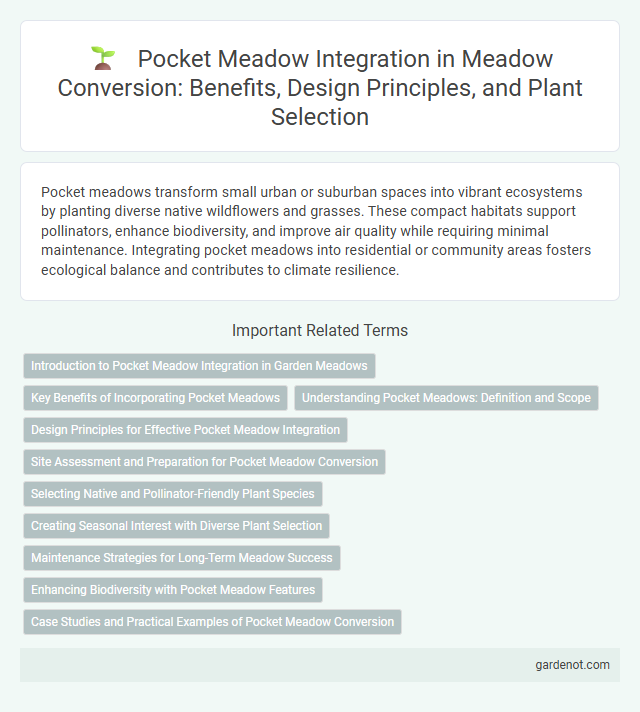Pocket meadows transform small urban or suburban spaces into vibrant ecosystems by planting diverse native wildflowers and grasses. These compact habitats support pollinators, enhance biodiversity, and improve air quality while requiring minimal maintenance. Integrating pocket meadows into residential or community areas fosters ecological balance and contributes to climate resilience.
Introduction to Pocket Meadow Integration in Garden Meadows
Pocket Meadow integration enhances garden meadows by introducing compact, biodiverse habitats that support native flora and fauna. These small-scale pockets increase ecological connectivity and improve soil health through diverse plant species adapted to local conditions. Incorporating Pocket Meadows optimizes space utilization while promoting pollinator activity and natural pest control within larger garden ecosystems.
Key Benefits of Incorporating Pocket Meadows
Pocket meadows enhance urban biodiversity by providing habitats for pollinators such as bees and butterflies, supporting local ecosystems. They improve air quality and reduce urban heat by increasing green spaces within densely built environments. These small-scale meadows promote mental well-being and community engagement through their natural, low-maintenance beauty.
Understanding Pocket Meadows: Definition and Scope
Pocket meadows are small, intentionally designed natural habitats that support diverse native flora and fauna within urban or suburban environments. These green spaces typically range from a few square meters to several hundred square meters, offering critical ecological functions such as pollinator support, soil enhancement, and microclimate regulation. By mimicking natural meadow ecosystems, pocket meadows contribute to biodiversity conservation and provide aesthetic and environmental benefits in compact, human-dominated landscapes.
Design Principles for Effective Pocket Meadow Integration
Pocket meadow integration emphasizes native plant diversity to enhance urban biodiversity and support pollinator habitats. Strategic spatial planning incorporates layered vegetation structures, promoting ecological resilience within limited spaces. Sustainable soil management and seasonal flowering cycles optimize ecosystem services and aesthetic value in pocket meadows.
Site Assessment and Preparation for Pocket Meadow Conversion
Site assessment for pocket meadow conversion involves evaluating soil quality, drainage, existing vegetation, and sunlight exposure to ensure optimal growing conditions for native wildflowers and grasses. Preparation includes removing non-native or invasive species, loosening compacted soil, and adding organic matter or nutrients as needed to create a fertile and well-drained substrate. Proper site preparation enhances biodiversity, supports pollinators, and establishes a sustainable pocket meadow ecosystem.
Selecting Native and Pollinator-Friendly Plant Species
Selecting native and pollinator-friendly plant species is essential for successful pocket meadow conversion, enhancing biodiversity and ecosystem resilience. Native plants adapted to local soil and climate conditions support native pollinators such as bees, butterflies, and hummingbirds by providing nectar and habitat. Incorporating a diverse mix of flowering species with staggered bloom times ensures continuous food sources throughout the growing season, promoting pollinator health and landscape sustainability.
Creating Seasonal Interest with Diverse Plant Selection
Pocket meadows enhance seasonal interest by incorporating a diverse selection of native wildflowers and grasses that bloom at staggered intervals throughout the year. This plant diversity supports local biodiversity by attracting pollinators such as bees and butterflies while providing habitat for beneficial insects. Strategic layering of early spring bulbs, summer perennials, and autumn seed heads ensures dynamic visual appeal and ecological value across seasons.
Maintenance Strategies for Long-Term Meadow Success
Effective maintenance strategies for pocket meadows include selective mowing, periodic invasive species removal, and targeted watering to support native plant growth. Implementing seasonal management practices such as cutting in late summer encourages biodiversity by allowing wildflowers to seed and insects to thrive. Monitoring soil health and adjusting interventions based on local climate conditions further ensures the long-term ecological balance and sustainability of pocket meadows.
Enhancing Biodiversity with Pocket Meadow Features
Pocket meadows enhance biodiversity by providing diverse plant species that support pollinators, birds, and small wildlife in urban environments. Their layered vegetation structure creates microhabitats, improving ecological resilience and connectivity between green spaces. Incorporating native flowers, grasses, and shrubs in pocket meadow designs boosts local ecosystem health and sustains pollinator populations.
Case Studies and Practical Examples of Pocket Meadow Conversion
Pocket meadow conversion projects showcase successful urban biodiversity enhancement by transforming small, underutilized green spaces into thriving wildflower habitats. Case studies reveal increased pollinator activity, improved soil health, and greater community engagement in cities like London and Manchester. Practical examples highlight effective plant species selection, minimal maintenance practices, and measurable ecological benefits within months of establishment.
Pocket meadow Infographic

 gardenot.com
gardenot.com